Michael Zhang นักเดินทางชาวจีนที่มีประสบการณ์ท่องเที่ยวระหว่างประเทศอย่างกว้างขวาง ผมหลงใหลในการค้นหาสมบัติทางประวัติศาสตร์ที่ซ่อนอยู่ในวัฒนธรรมต่างๆ โดยเฉพาะโบราณสถานที่มีความสำคัญระดับโลกอย่างทหารดินเผา ผมชอบแบ่งปันมุมมองเกี่ยวกับประวัติศาสตร์ วัฒนธรรม และการท่องเที่ยวเชิงลึกผ่านบทความ หวังว่าคอนเทนต์ของผมจะช่วยให้นักท่องเที่ยวเข้าใจถึงความยิ่งใหญ่ของสิ่งมหัศจรรย์ทางประวัติศาสตร์เหล่านี้ได้ดียิ่งขึ้น และยังเป็นคู่มือการเดินทางที่มีประโยชน์ให้กับคุณ บทความนี้จะพาคุณไปสัมผัสการเดินทางทางวัฒนธรรมที่ลึกซึ้งสู่โลกของทหารดินเผา
สารบัญบทความ
การแนะนำทหารดินเผา
ทหารดินเผา หรือสุสานทหารดินเผาของจักรพรรดิฉินสื่อหวง เรียกสั้นๆ ว่าฉินทหารดินเผา ตั้งอยู่ในเขตหลินถง เมืองซีอาน มณฑลส่านซี ห่างจากสุสานจักรพรรดิฉินสื่อหวงไปทางทิศตะวันออกราว 1.5 กิโลเมตร ตั้งแต่การค้นพบ มีผู้นำประเทศและหัวหน้ารัฐบาลมากกว่า 200 คนจากทั่วโลกเดินทางมาเยี่ยมชม ที่นี่จึงกลายเป็นสัญลักษณ์แห่งอารยธรรมจีนโบราณ และได้รับการยกย่องให้เป็นหนึ่งในสิบสิ่งมหัศจรรย์ของสุสานโลก ทหารดินเผาจัดอยู่ในประเภทประติมากรรมฝังศพในสมัยโบราณ ในยุคที่ระบบทาสยังคงมีอยู่ ทาสมักจะถูกฝังไปพร้อมกับเจ้านายเมื่อเสียชีวิต แต่ทหารดินเผาแตกต่างออกไป เนื่องจากถูกสร้างขึ้นเลียนแบบรูปร่างของรถศึก ม้า และทหาร เพื่อใช้แทนการฝังคนจริงๆ ไปเป็นผู้ติดตามจักรพรรดิฉินสื่อหวง
ทหารดินเผาถูกค้นพบโดยบังเอิญในเดือนมีนาคม ปี ค.ศ. 1974 และในปี ค.ศ. 1987 สุสานจักรพรรดิฉินสื่อหวงพร้อมกับบ่อทหารดินเผาได้รับการขึ้นทะเบียนเป็นมรดกโลกโดยองค์การยูเนสโก และได้รับสมญานามว่า “สิ่งมหัศจรรย์ลำดับที่แปดของโลก”
- ที่อยู่: ถนนฉินหลิงเหนือ เขตหลินถง เมืองซีอาน มณฑลส่านซี
- เวลาเปิดทำการ:
- 16 มีนาคม – 15 พฤศจิกายน: 08:30-17:00
- 16 พฤศจิกายน – 15 มีนาคม: 08:30-16:30
- เวลาเที่ยวที่แนะนำ: 3 ชั่วโมง
- ฤดูกาลที่เหมาะสม: เที่ยวได้ตลอดทั้งปี
- วิธีซื้อตั๋ว: คลิกเพื่อซื้อ
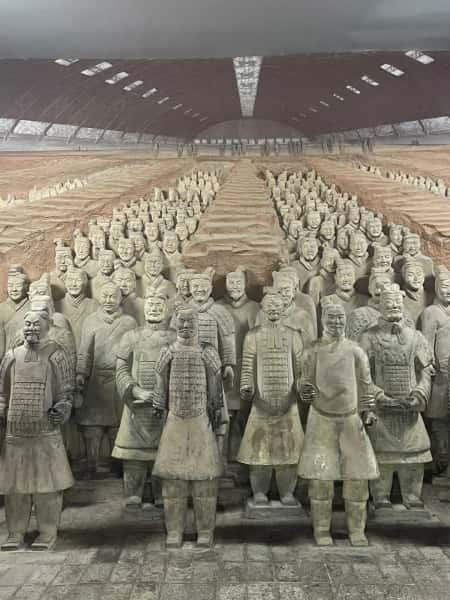
ทำไมทหารดินเผาถึงควรไปชม?
ทหารดินเผาไม่เพียงเป็นการค้นพบทางโบราณคดีที่มีคุณค่าเชิงท่องเที่ยวสูง แต่ยังเต็มไปด้วยความสำคัญทางประวัติศาสตร์ วัฒนธรรม และศิลปะอีกด้วย การได้ชมประติมากรรมที่เหมือนจริงเหล่านี้ ทำให้เราเข้าใจโครงสร้างทางทหาร เทคโนโลยีงานฝีมือ และวัฒนธรรมสังคมของราชวงศ์ฉินได้อย่างลึกซึ้ง อีกทั้งยังได้รับการขนานนามว่าเป็น “สิ่งมหัศจรรย์ลำดับที่แปดของโลก” ด้วยขนาดที่ยิ่งใหญ่และฝีมือการปั้นที่ประณีต ทำให้ผู้มาเยือนได้รับความประทับใจ และนี่คือหน้าต่างอันล้ำค่าในการเรียนรู้เกี่ยวกับอารยธรรมจีนโบราณ
เหตุผลในการสร้างทหารดินเผา
จุดประสงค์หลักของจักรพรรดิฉินสื่อหวงในการสร้างทหารดินเผา คือเพื่อให้กองทัพนี้ปกป้องพระองค์ในโลกหลังความตาย และเพื่อสืบต่ออำนาจการปกครองของพระองค์ แม้หลังจากสิ้นพระชนม์แล้ว พระองค์ยังคงหวังจะมีกองทัพอันแข็งแกร่งอยู่เคียงข้าง ป้องกันการรุกรานหรือการโจมตีที่อาจเกิดขึ้น ด้วยเหตุนี้จึงมีการสั่งสร้างหุ่นดินเผาขนาดเท่าคนจริงเป็นสัญลักษณ์ของกองทัพ และฝังไว้ใต้ดิน ซึ่งสะท้อนให้เห็นถึงอำนาจทางทหารของราชวงศ์ฉิน
แผนที่ภายในอุทยานทหารดินเผา
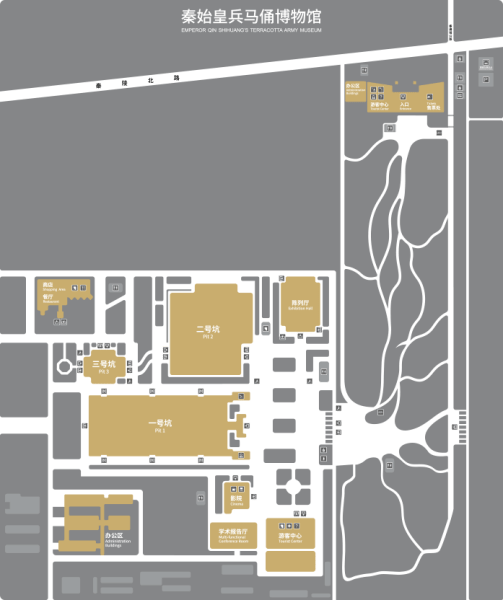
สถานที่ที่ต้องไปเยือนในทหารดินเผา
การชมจุดสำคัญภายในอุทยาน
อุทยานทหารดินเผาหลักๆ แบ่งออกเป็น ลี่ซานหยวน หลุมหมายเลข 1 หลุมหมายเลข 2 และหลุมหมายเลข 3 โดยแต่ละโซนมีรายละเอียดที่น่าสนใจดังนี้
ลี่ซานหยวน (สุสานจักรพรรดิฉินสื่อหวง)
ลี่ซานหยวนเป็นพื้นที่หลักของสุสานจักรพรรดิฉินสื่อหวง มีขนาดกว้างใหญ่ สะท้อนถึงความยิ่งใหญ่และอำนาจของราชวงศ์ฉิน การจัดผังภายในแสดงให้เห็นถึงเอกลักษณ์ด้านสถาปัตยกรรมของสุสานจักรพรรดิฉิน เป็นสถานที่เหมาะอย่างยิ่งในการเรียนรู้วิถีชีวิตและแนวคิดในการปกครองของจักรพรรดิฉินสื่อหวง นักท่องเที่ยวสามารถสัมผัสบรรยากาศทางประวัติศาสตร์และใกล้ชิดกับสถาปัตยกรรมโบราณที่ทรงคุณค่า
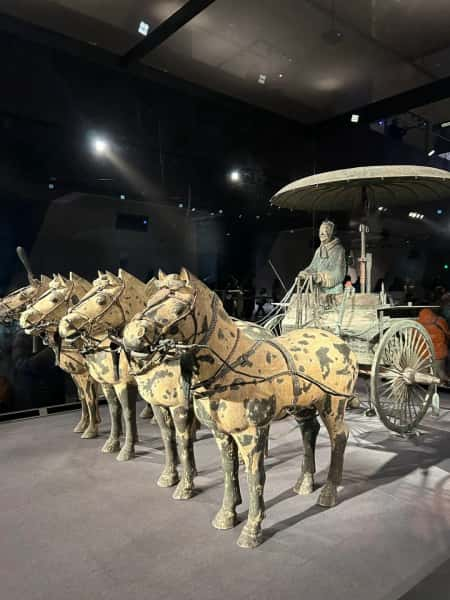
หลุมหมายเลข 1
หลุมหมายเลข 1 ถือเป็นหลุมหลักของทหารดินเผา มีพื้นที่ประมาณ 14,260 ตารางเมตร ขนาดใหญ่อลังการ ภายในมีรูปปั้นทหารและม้าดินเผามากกว่า 6,000 ชิ้น ที่นี่เผยให้เห็นพลังอำนาจและการจัดระเบียบที่เข้มแข็งของกองทัพฉิน รูปปั้นทหารถูกจัดเรียงอย่างเป็นระเบียบ แต่ละองค์มีรายละเอียดสมจริง ทำให้ผู้ชมรู้สึกเหมือนย้อนเวลากลับไปยังสมรภูมิของกองทัพฉิน และสัมผัสได้ถึงความยิ่งใหญ่ชวนตื่นตะลึง
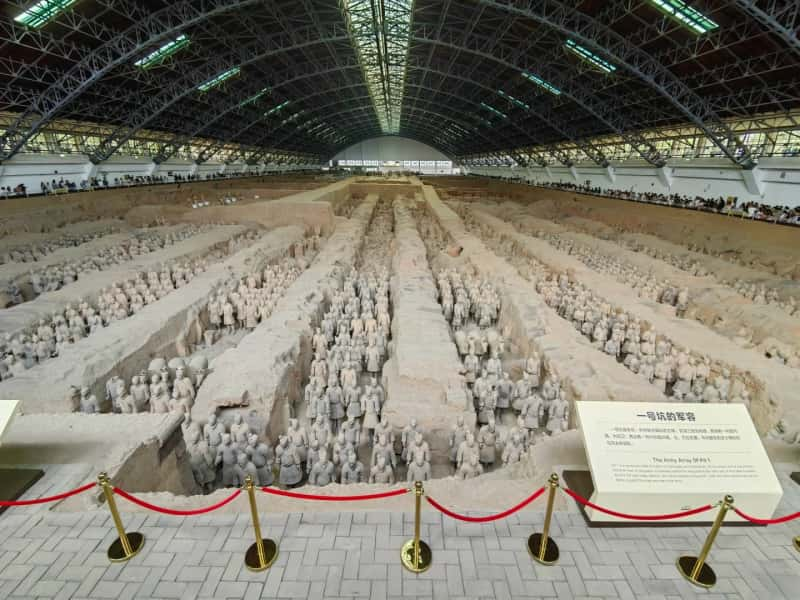
หลุมหมายเลข 2
หลุมหมายเลข 2 เป็นพื้นที่จัดแสดงหน่วยรบหลากหลายประเภท เช่น พลธนู ทหารราบ ทหารม้า และรถศึก แสดงให้เห็นถึงการจัดกำลังพลที่ยืดหยุ่นและยุทธศาสตร์ที่แยบยลของกองทัพฉิน รูปปั้นแต่ละประเภทถูกจัดตามโครงสร้างการรบอย่างชัดเจน ทำให้เห็นถึงความหลากหลายและศิลปะการทหารที่ล้ำสมัยในยุคนั้น
หลุมหมายเลข 3
หลุมหมายเลข 3 ถือเป็นศูนย์บัญชาการ แม้จะมีขนาดเล็กกว่าหลุมอื่น แต่เป็นสัญลักษณ์ของสติปัญญาและอำนาจของแม่ทัพ ภายในมีจำนวนรูปปั้นทหารและอาวุธไม่มากนัก แต่แสดงให้เห็นระบบการบัญชาการของกองทัพฉิน ทำให้นักท่องเที่ยวเข้าใจโครงสร้างและการวางแผนทางการทหารของยุคราชวงศ์ฉินได้ลึกซึ้งยิ่งขึ้น
คู่มือบัตรเข้าชมทหารดินเผา
ราคาบัตรเข้าชม
- บัตรผู้ใหญ่: 120 หยวน สำหรับนักท่องเที่ยวอายุ 16-65 ปี
- สิทธิพิเศษ: เด็กอายุต่ำกว่า 16 ปี และผู้สูงอายุเกิน 65 ปี เข้าชมฟรี
- บัตรรวม: ตั๋วทหารดินเผาครอบคลุมค่าเข้าชมลี่ซานหยวนด้วย
หมายเหตุ: บัตรต้องซื้อตามรอบเวลา แม้ว่าจะสามารถเข้าชมนอกช่วงเวลาก็ได้ แต่แนะนำให้เข้าตามรอบที่ซื้อไว้เพื่อความสะดวก
วิธีการซื้อตั๋ว
- ซื้อออนไลน์: ผ่านเว็บไซต์ทางการ หรือเอเจนซี่ท่องเที่ยว
- วิธีซื้อตั๋ว: คลิกเพื่อซื้อ
- ซื้อหน้างาน: สามารถซื้อได้ที่ตู้จำหน่ายบัตรอัตโนมัติในอุทยาน เพียงกรอกชื่อภาษาอังกฤษและหมายเลขพาสปอร์ตตามที่ระบุในหนังสือเดินทาง
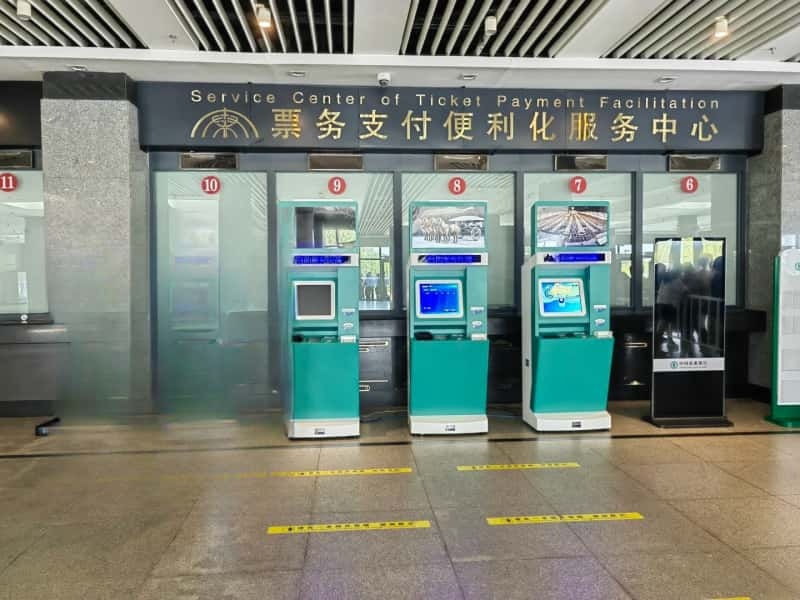
รถบริการรับ-ส่งภายในอุทยาน
- ค่ารถไฟฟ้า: 15 หยวนต่อคน ใช้ได้หลายครั้ง
- คำแนะนำ: ควรเลือกนั่งแถวหลังสุดของรถไฟฟ้าเพื่อชมวิวที่สวยงามกว่า
บริการไกด์นำเที่ยวทหารดินเผา
หากต้องการเข้าใจประวัติศาสตร์และศิลปะอันวิจิตรของทหารดินเผาอย่างลึกซึ้ง แนะนำให้ใช้บริการไกด์นำเที่ยว โดยอุทยานมีตัวเลือกดังนี้
ไกด์นำเที่ยวลี่ซานหยวน
เนื้อหาการบรรยายครอบคลุม สุสานจักรพรรดิฉินสื่อหวง จุด K9901 จุด K0006 และพิพิธภัณฑ์รถม้าสำริด
- ไกด์ภาษาต่างประเทศ (อังกฤษและญี่ปุ่น): ค่าใช้จ่าย 500 หยวนต่อหนึ่งไกด์ รับได้สูงสุด 5 คน ใช้เวลา 60-90 นาที
- ไกด์ภาษาจีน: ค่าใช้จ่าย 300 หยวนต่อหนึ่งไกด์ รับได้สูงสุด 5 คน ใช้เวลา 60-90 นาที
ไกด์นำเที่ยวพิพิธภัณฑ์ทหารดินเผา
เนื้อหาครอบคลุมหลุมหมายเลข 1 หมายเลข 2 และหมายเลข 3
- ไกด์ภาษาต่างประเทศ (อังกฤษและญี่ปุ่น): ค่าใช้จ่าย 500 หยวนต่อหนึ่งไกด์ รับได้สูงสุด 5 คน ใช้เวลา 60-90 นาที
- ไกด์ภาษาจีน: ค่าใช้จ่าย 300 หยวนต่อหนึ่งไกด์ รับได้สูงสุด 5 คน ใช้เวลา 60-90 นาที
คำเตือน: ภายในอุทยานมีไกด์เถื่อนจำนวนมาก ควรตรวจสอบให้รอบคอบ เพื่อความมั่นใจในคุณภาพการบรรยาย ควรจองไกด์ผ่านบริษัททัวร์ล่วงหน้า
เส้นทางแนะนำในการชมทหารดินเผา
เพื่อให้ได้ประสบการณ์การท่องเที่ยวที่ดีที่สุด แนะนำให้เริ่มชมลี่ซานหยวนในช่วงเช้า เนื่องจากคนไม่เยอะนัก แล้วค่อยไปชมทหารดินเผาในช่วงบ่าย เวลานั้นกลุ่มทัวร์ส่วนใหญ่จะเดินทางออกไปแล้ว หลังจากชมลี่ซานหยวน สามารถนั่งรถรับส่งฟรีไปยังพิพิธภัณฑ์สุสานจักรพรรดิฉินสื่อหวงได้
- เส้นทางชมลี่ซานหยวน: ทางเข้า → หลุมฝัง K9901 → พิพิธภัณฑ์รถม้าสำริด → หลุมฝัง K0006 → สุสานจักรพรรดิฉิน → ทางออก
- เส้นทางชมทหารดินเผา: หลุมหมายเลข 1 → หลุมหมายเลข 3 → หลุมหมายเลข 2 → ห้องจัดแสดงโบราณวัตถุ
เคล็ดลับ: ภายในแต่ละหลุมของทหารดินเผาไม่มีเครื่องปรับอากาศ หากมาในฤดูร้อนอากาศจะร้อนอบอ้าวเหมือนอยู่ในห้องอบไอน้ำ ควรเตรียมพัดลมพกพาติดตัวไป
การสะสมตราประทับและของที่ระลึกทหารดินเผา
หลังจากชมทหารดินเผาแล้ว นักท่องเที่ยวสามารถสะสมตราประทับที่ระลึกและเลือกซื้อของฝากเฉพาะถิ่นภายในอุทยาน เพื่อเก็บความทรงจำพิเศษไว้ในทริปครั้งนี้
ร้านของที่ระลึกทางการ
- ตำแหน่ง: ด้านซ้ายของทางออกหลุมหมายเลข 2
- ข้อมูลตราประทับ:
- หน้าร้านมีตราประทับฟรีแบบทั่วไป แต่หมึกอาจไม่เข้มมากนัก
- เมื่อซื้อสินค้าใดๆ ภายในร้าน จะได้รับตราประทับทั่วไป
- หากซื้อสินค้าลิขสิทธิ์บางรายการ จะได้รับตราประทับพิเศษแบบเฉพาะ
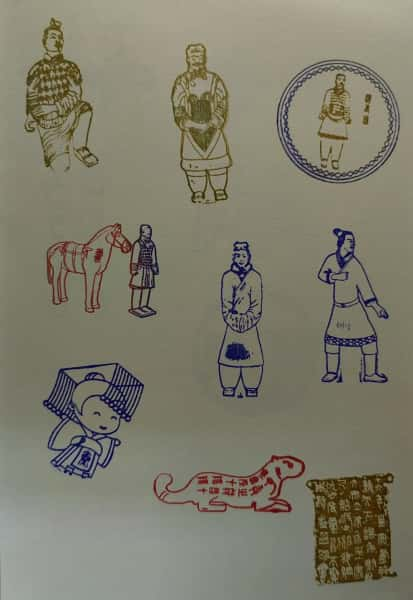
ไปรษณีย์ธีมทหารดินเผา
- ตำแหน่ง: ใกล้ทางออก
- ข้อมูลตราประทับ:
- หน้าร้านมีตราประทับสีฟรี
- ภายในร้านมีตราประทับธีมพิเศษ 2 แบบ เหมาะสำหรับนักสะสมแสตมป์และผู้ที่ชอบเก็บของที่ระลึก
สามารถนำทหารดินเผากลับบ้านได้หรือไม่?
แม้ไม่สามารถนำทหารดินเผาจริงกลับบ้านได้ แต่สามารถซื้อโมเดลทหารดินเผาที่ได้รับการรับรองอย่างเป็นทางการเป็นของที่ระลึกได้ โมเดลเหล่านี้มีหลากหลายรูปแบบ บางชุดมี 3 ชิ้น ราคาประมาณ 1,350 หยวน โมเดลถูกออกแบบอย่างละเอียดเหมือนจริง เหมาะสำหรับนักท่องเที่ยวที่ต้องการเก็บไว้เป็นที่ระลึกของการเดินทางทางประวัติศาสตร์ครั้งนี้
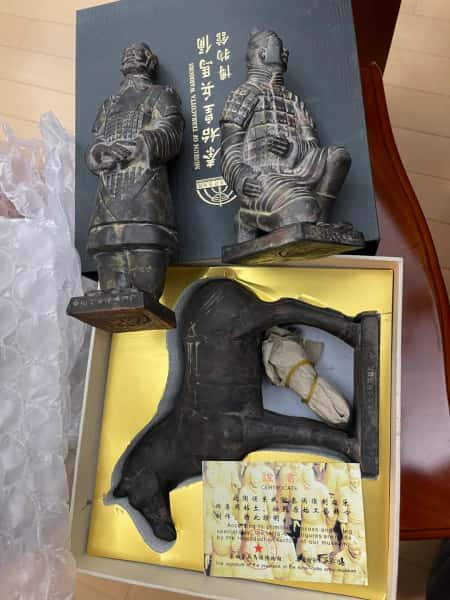
วิธีเดินทางจากตัวเมืองซีอานไปยังทหารดินเผา
รถไฟใต้ดิน + รถบัส
- เส้นทางรถไฟใต้ดิน: จากใจกลางเมืองนั่งรถไฟฟ้าใต้ดินสาย 1 ไปยังสถานี Fangzhicheng จากนั้นเปลี่ยนเป็นสาย 9 ไปลงที่สถานี Huaqingchi
- การต่อรถบัส: ออกจากสถานี Huaqingchi ทางออก C เดินประมาณ 200 เมตรไปยังป้ายรถบัส Huaqingchi แล้วขึ้นรถบัสสาย Lintong 613 หรือ Lintong 602 ไปลงที่ป้ายทหารดินเผา
รถบัสตรง
- จุดขึ้นรถ: สถานีรถไฟใต้ดิน Zhonglou ทางออก G1 มีรถบัสสายตรงไปยังทหารดินเผา
- เวลาออก: วันละ 2 รอบ เวลา 09:00 น. และ 10:00 น. ใช้เวลาประมาณ 1 ชั่วโมง
- ค่าโดยสาร: ผู้ใหญ่ 25 หยวน เด็ก 20 หยวน
รถแท็กซี่
- เวลาเดินทาง: จากตัวเมืองไปพิพิธภัณฑ์ทหารดินเผา ใช้เวลาประมาณ 40-50 นาที
- ค่าโดยสารโดยประมาณ: ประมาณ 120 หยวน
ร้านอาหารแนะนำใกล้ทหารดินเผา
หลังจากชมทหารดินเผาแล้ว ควรลองลิ้มรสอาหารท้องถิ่นดังนี้:
- ไอศกรีมทหารดินเผา: ทำเป็นรูปทหารดินเผา ราคาประมาณ 20 หยวน ทั้งอร่อยและเหมาะเป็นที่ระลึก
- Wei Jia Liang Pi (魏家涼皮): ขึ้นชื่อเรื่อง liangpi และ roujiamo ค่าใช้จ่ายเฉลี่ยคนละ 20 หยวน ที่อยู่: บริเวณบริการนักท่องเที่ยว พิพิธภัณฑ์ทหารดินเผา เขตหลินถง ซีอาน ห้อง F15-01
- ร้าน Lao Yang Jia Niu Yang Rou Pao Mo (老楊家牛羊肉泡饃館): เน้นอาหารประเภทแป้ง เช่น paomo เกี๊ยว และ biangbiang mian ค่าใช้จ่ายเฉลี่ยคนละ 35 หยวน ที่อยู่: จัตุรัสท่องเที่ยวทหารดินเผา เขตหลินถง ซีอาน
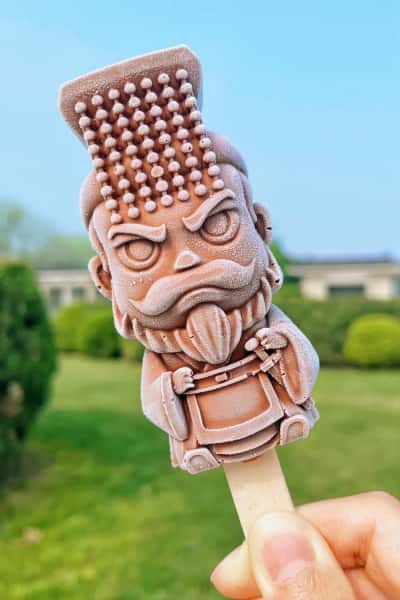
ขั้นตอนการสร้างทหารดินเผา
ขั้นตอนการสร้างทหารดินเผาประกอบด้วย:
- การขึ้นรูป: ใช้วิธีปั้นดินเป็นเส้นแล้วประกอบขึ้นเป็นรูปร่าง ก่อนนำแม่พิมพ์มาประกอบเป็นโครงหลัก หัวและมือถูกทำแยกออกมา แล้วประกอบเข้ากับลำตัวภายหลัง
- การแกะสลักรายละเอียด: แกะสลักใบหน้า เกราะ และเสื้อผ้าอย่างละเอียด แต่ละรูปปั้นมีใบหน้าไม่เหมือนกัน ทำให้เกิดเอฟเฟกต์ “หนึ่งพันคน หนึ่งพันหน้า”
- การเผา: หลังแกะสลักแล้วจะนำไปเผาในเตา การควบคุมอุณหภูมิเป็นหัวใจสำคัญเพื่อให้ได้ความแข็งแรงและสีที่เหมาะสม
- การลงสี: หลังจากเผาเสร็จ จะลงสีเพื่อเพิ่มความสมจริงและคุณค่าทางศิลปะ ขั้นตอนนี้ช่วยให้ทหารดินเผามีรายละเอียดและความงดงามมากยิ่งขึ้น
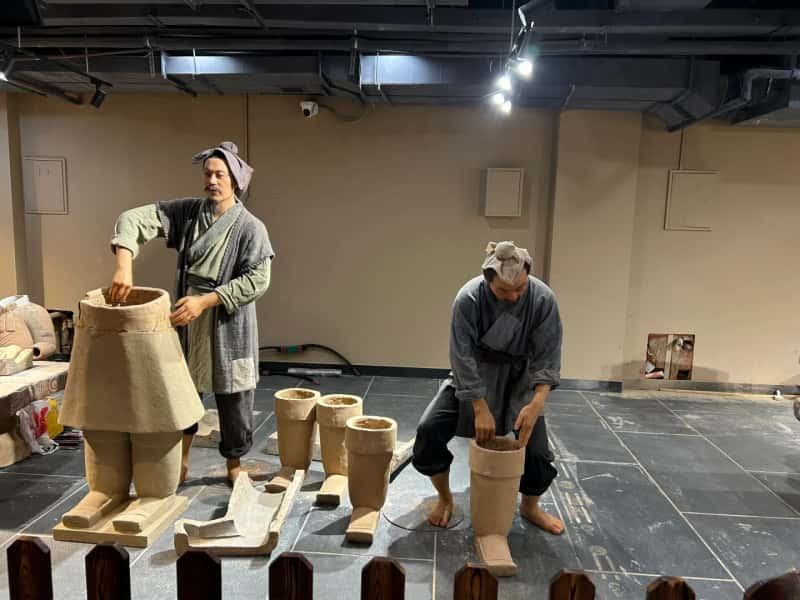
ทหารดินเผาถูกค้นพบได้อย่างไร?
ในปี ค.ศ. 1974 ชาวนาในท้องถิ่นชื่อหยาง หงเซิง ขณะขุดบ่อน้ำในเขตชานเมืองซีอาน มณฑลส่านซี ได้พบเศษดินเผาโดยบังเอิญ หลังจากนั้นก็พบชิ้นส่วนดินเผาเพิ่มเติม เขาจึงรายงานเรื่องนี้ต่อหน่วยงานที่เกี่ยวข้อง การค้นพบครั้งนั้นนำไปสู่การสืบสวนโดยนักโบราณคดี และในที่สุดยืนยันได้ว่าชิ้นส่วนเหล่านี้มาจากรูปปั้นทหารดินเผาขนาดใหญ่ที่ถูกฝังอยู่ใต้ดิน ตลอดหลายปีของการขุดค้น มีการพบรูปปั้นทหารดินเผาหลายพันองค์ในพื้นที่ใกล้สุสานจักรพรรดิฉินสื่อหวง รูปปั้นเหล่านี้ทำหน้าที่เป็นเครื่องบูชาฝังร่วมในสุสาน เพื่อปกป้องและติดตามจักรพรรดิในโลกหน้า
การค้นพบครั้งนี้สร้างความฮือฮาไปทั่วโลก จุดกระแสการวิจัยอย่างกว้างขวาง และทำให้ผู้คนเข้าใจถึงประวัติศาสตร์การทหารและวัฒนธรรมจีนโบราณมากยิ่งขึ้น อีกทั้งยังเป็นหลักฐานล้ำค่าสำหรับนักโบราณคดีในการศึกษาอดีต
ทหารดินเผามีอาวุธหรือไม่?
ทหารดินเผาถูกสร้างขึ้นพร้อมอาวุธจริงเป็นจำนวนมาก รูปปั้นส่วนใหญ่ถืออาวุธ เช่น ธนู หน้าไม้ หอก ดาบ และดาบโค้ง อาวุธหลายชิ้นเมื่อถูกขุดขึ้นมาก็ยังคมกริบ แสดงให้เห็นถึงฝีมือช่างที่ยอดเยี่ยมในยุคนั้น
ส่วนประเด็นเรื่องอาวุธบางส่วนที่หายไปนั้น มีทฤษฎีหนึ่งกล่าวว่าอาจเกิดจากการที่เซียงอวี่เข้ามาในแถบกวนจงแล้วทำลายสุสานจักรพรรดิฉินเพื่อแก้แค้น และยึดอาวุธไป อย่างไรก็ตาม ข้อสันนิษฐานนี้ยังไม่มีหลักฐานชัดเจนสนับสนุน เนื่องจากบันทึกทางประวัติศาสตร์เกี่ยวกับการกระทำของเซียงอวี่ในเหตุการณ์นั้นค่อนข้างจำกัด
ทำไมเราต้องปกป้องทหารดินเผา?
ก่อนอื่น ทหารดินเผาคือมรดกทางวัฒนธรรมและประวัติศาสตร์ที่สำคัญยิ่งของจีน มีคุณค่ามหาศาลในเชิงประวัติศาสตร์ ในฐานะส่วนหนึ่งของสุสานจักรพรรดิฉินสื่อหวง มันสะท้อนให้เห็นถึงระดับการทหาร ศิลปะ และวัฒนธรรมในสมัยราชวงศ์ฉิน ทหารดินเผาไม่เพียงเป็นตัวแทนงานประติมากรรมฝังศพที่ยิ่งใหญ่ แต่ยังสะท้อนโครงสร้างการทหารและวิถีชีวิตสังคมในยุคนั้น ดังนั้น การปกป้องทหารดินเผาจึงมีความหมายอย่างมากต่อการศึกษาประวัติศาสตร์จีนโบราณ
นอกจากนี้ การอนุรักษ์ทหารดินเผายังสำคัญอย่างยิ่ง เพราะวัสดุและสภาพแวดล้อมที่เปราะบางทำให้เสี่ยงต่อความเสียหาย งานวิจัยทางวิทยาศาสตร์ชี้ว่าโบราณวัตถุที่มีการระบายสีเช่นทหารดินเผามีความเปราะมาก จำเป็นต้องใช้เทคโนโลยีขั้นสูง เช่น การวิเคราะห์สีด้วยสเปกตรัมและการสร้างแบบจำลอง 3 มิติ ในการซ่อมแซมและปกป้อง ดังนั้น การรักษาทหารดินเผาให้อยู่ในสภาพสมบูรณ์จำเป็นต้องอาศัยเทคโนโลยีและอุปกรณ์ที่แม่นยำ เพื่อสืบทอดคุณค่าทางประวัติศาสตร์นี้ต่อไปอย่างยั่งยืน
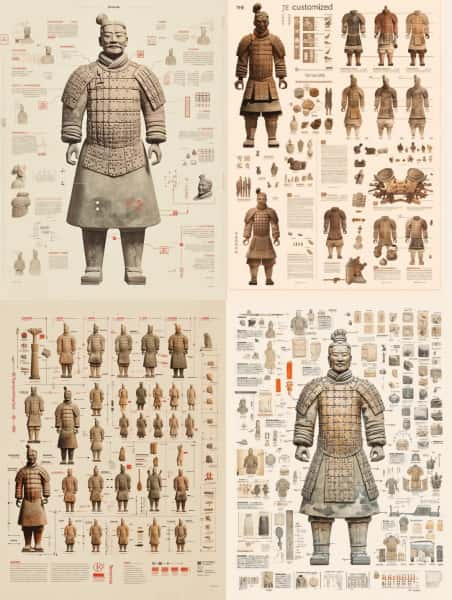
ประเภทของทหารดินเผามีอะไรบ้าง?
ทหารดินเผาสามารถแบ่งออกตามตำแหน่งได้เป็น 2 ประเภทใหญ่ ได้แก่ ทหารและนายทหาร โดยนายทหารยังแบ่งย่อยเป็นระดับล่าง ระดับกลาง และระดับสูง ทหารทั่วไปจะไม่สวมมงกุฎ ในขณะที่นายทหารจะสวมมงกุฎ ซึ่งมงกุฎของนายทหารทั่วไปกับแม่ทัพก็แตกต่างกัน รวมถึงเกราะที่ใส่ก็ไม่เหมือนกันเช่นกัน ในกองทัพดินเผามีทหารราบ ทหารม้า และทหารรถศึก ซึ่งอุปกรณ์การรบจะแตกต่างกันไปตามความต้องการในสนามรบ แสดงให้เห็นถึงความหลากหลายทางยุทธวิธีของกองทัพฉิน
ในบ่อขุดพบ ส่วนใหญ่คือรูปปั้นนักรบ ถืออาวุธทองสัมฤทธิ์ เช่น ธนู หน้าไม้ หอก ดาบ หรือหอกง้าว ทหารเหล่านี้สวมเกราะที่ทำจากแผ่นเล็กๆ เชื่อมต่อกัน และตกแต่งด้วยสายเชือกที่หน้าอก นายทหารจะสวมมงกุฎยาว และมีจำนวนน้อยกว่านักรบทั่วไป ใบหน้า รูปร่าง และอายุของรูปปั้นแต่ละองค์ยังแตกต่างกัน ทำให้มีความสมจริงอย่างยิ่ง
ทหารรถศึก
ทหารรถศึกคือนักรบบนรถศึก นอกจากผู้ควบคุมรถแล้ว โดยทั่วไปจะมีทหาร 2 คน คือ ทหารด้านซ้ายและทหารด้านขวา ทหารด้านซ้ายสวมเสื้อยาวคลุมเกราะ ศีรษะสวมหมวกแบบจีนโบราณ มือซ้ายถืออาวุธยาว เช่น หอกหรือทวน ส่วนมือขวาประคองรถ ส่วนทหารด้านขวาสวมชุดเช่นเดียวกันแต่ทำท่าตรงกันข้าม ทั้งคู่เป็นกำลังหลักของรถศึก จากอาวุธที่ขุดพบทำให้เห็นว่าพวกเขามีทั้งอาวุธประชิดและอาวุธไกล เช่น หอกและหน้าไม้ นอกจากนี้ยังมีนายทหารประจำรถที่ทำหน้าที่สั่งการเพื่อเพิ่มประสิทธิภาพในการรบ
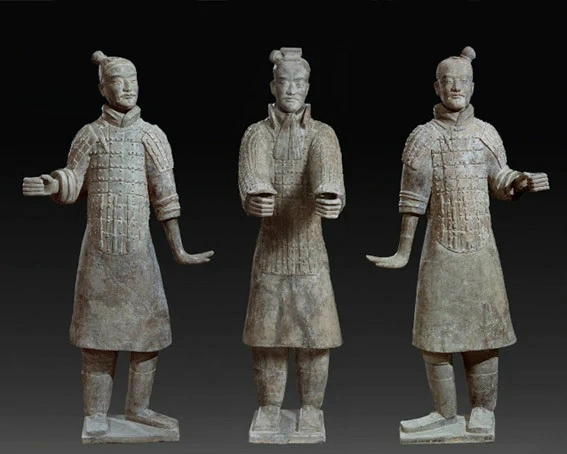
ทหารยิงธนูยืน
ทหารยิงธนูยืนเป็นประเภทพิเศษ พบในหลุมหมายเลข 2 ทางตะวันออก พวกเขาถือหน้าไม้และยืนอยู่แถวหน้า ขณะที่ทหารยิงธนูนั่งคุกเข่าอยู่แถวใน เครื่องแต่งกายของพวกเขาเป็นชุดรบเบา มวยผมขึ้นสูง คาดเข็มขัดหนัง และใส่รองเท้าปลายเชิด ท่วงท่าการยิงธนูตรงกับบันทึกโบราณในตำรา Wu Yue Chunqiu ที่อธิบายท่าการยิงไว้อย่างเป็นระบบ แสดงให้เห็นถึงทักษะการยิงธนูที่เป็นมาตรฐานสูงสุดในยุคนั้น
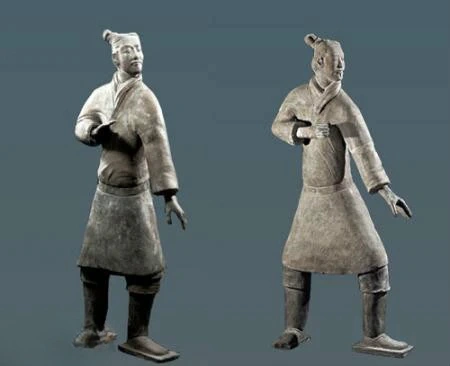
ทหารยิงธนูนั่งคุกเข่า
ทหารยิงธนูนั่งคุกเข่าก็พบในหลุมหมายเลข 2 ทางตะวันออกเช่นกัน ทำหน้าที่ร่วมกับทหารยิงธนูยืนในการจัดแนวหน้าไม้ โดยทหารคุกเข่าจะอยู่ตรงกลางแถว เขาสวมชุดรบคลุมเกราะ ผมถูกรวบไปด้านซ้าย ขาซ้ายงอ ขาขวาคุกเข่า ลำตัวเอียงเล็กน้อย มือทั้งสองจับคันธนูในท่ากำลังดึงสายธนู รายละเอียดอย่างพื้นรองเท้ายังถูกแกะสลักอย่างปราณีตจนมองเห็นรอยตะเข็บอย่างสมจริง ทหารยิงธนูนั่งคุกเข่าเป็นรูปปั้นที่สมบูรณ์ที่สุดเท่าที่เคยขุดพบ และเกราะด้านหลังยังคงมีร่องรอยสีแดงเหลืออยู่
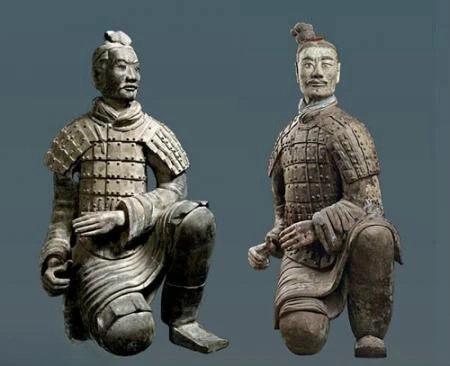
ทหารนักรบ
ทหารนักรบคือทหารทั่วไป มีความสูงเฉลี่ยราว 1.8 เมตร และเป็นประเภทที่พบมากที่สุดในบ่อขุด แบ่งเป็นทหารใส่ชุดรบธรรมดาและทหารใส่เกราะ ทหารชุดรบมักอยู่แถวรอบนอกเพื่อความคล่องตัว ขณะที่ทหารใส่เกราะจะอยู่ในแถวกลางเพื่อทำหน้าที่เป็นกำลังหลักในการรบ แต่ละคนถืออาวุธจริงเต็มอาวุธยุทโธปกรณ์ แสดงถึงพลังและบารมีของกองทัพฉิน
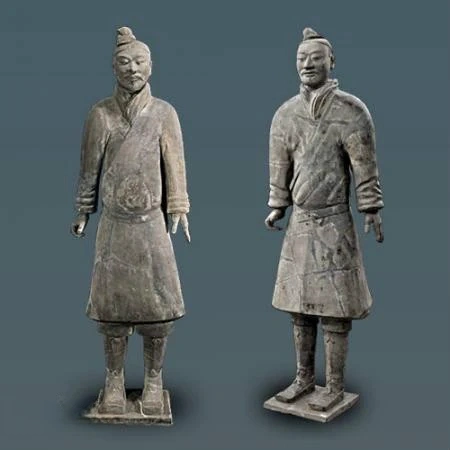
ทหารนายกอง
ทหารนายกองมีตำแหน่งต่ำกว่าแม่ทัพ แบ่งเป็นระดับกลางและระดับล่าง พบจำนวนน้อยมาก ไม่ถึงสิบองค์ แบ่งออกเป็นแบบใส่ชุดรบและใส่เกราะ นายกองใส่เกราะจะสวมมงกุฎยาวแบบคู่หรือแบบเดี่ยว เกราะมีลวดลายหลากหลาย ส่วนผู้ใส่ชุดรบแม้จะเรียบง่าย แต่มีเครื่องประดับตรงอก ส่วนผู้ใส่เกราะจะตกแต่งด้วยโบว์สีสดที่หน้าอก หลัง และไหล่ แสดงถึงสถานะและอำนาจ รูปร่างของนายกองโดยรวมจะสูงโปร่ง ไหล่กว้าง สีหน้าเข้มขรึม สื่อถึงความกล้าหาญและความรับผิดชอบ บางองค์ยังแสดงออกถึงความคิดถึงบ้านเกิดด้วย
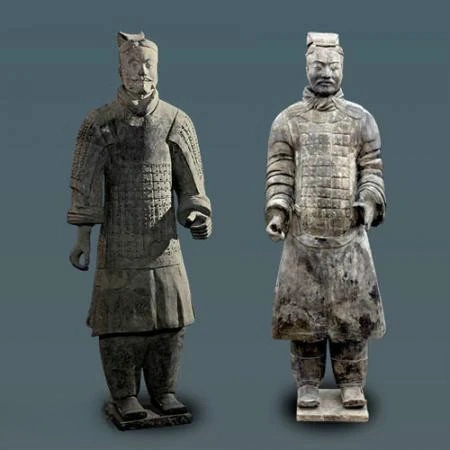
ทหารม้า
ในหลุมหมายเลข 1 และ 2 พบรูปปั้นทหารม้าทั้งหมด 116 องค์ ใช้เป็นกองกำลังจู่โจมในสนามรบ เครื่องแต่งกายแตกต่างจากทหารราบและทหารรถศึกอย่างชัดเจน ได้แก่ หมวกกลม เสื้อแขนรัด กางเกงขายาวรัดรูป รองเท้าสั้น และเกราะสั้นเบาเพื่อความคล่องตัว ทหารม้าที่ขุดพบในหลุมหมายเลข 2 ถือเป็นหลักฐานเก่าแก่ที่สุดเกี่ยวกับกองทหารม้าในประวัติศาสตร์จีนโบราณ
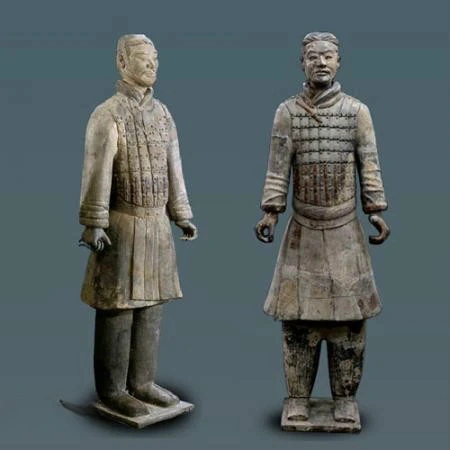
ทหารควบคุมรถ
ทหารควบคุมรถมีหน้าที่บังคับม้าและขับรถศึก พบได้ในทั้งสามหลุม เขาสวมเสื้อยาวทับเกราะ แขนมีกำไลเกราะป้องกัน มือใส่เกราะป้องกัน ขามีเกราะรองรับ และสวมหมวกผ้าพร้อมมงกุฎยาว แขนทั้งสองยกไปด้านหน้าในท่าถือบังเหียน เนื่องจากรถศึกมีอานุภาพในการทำลายสูงในสนามรบ ทำให้ทหารควบคุมรถมีความสำคัญอย่างยิ่งและสามารถชี้ขาดผลการศึกได้
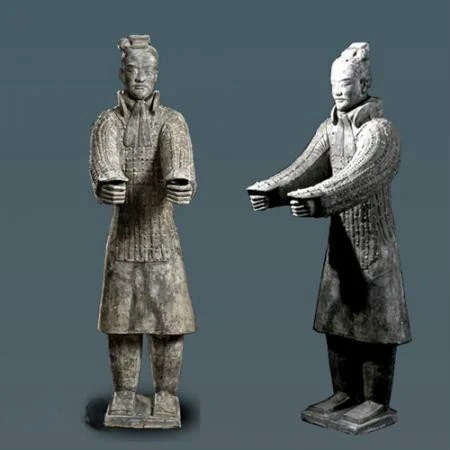
ม้าศึก
รถศึกแต่ละคันจะมีม้าดินเผา 4 ตัว ขนาดใกล้เคียงม้าจริง ความยาวราว 2.1 เมตร สูง 1.72 เมตร ม้าทั้งสี่มีท่าทางเหมือนกัน ขนแผงคอสั้น หางถักเป็นเปีย ศีรษะเชิดขึ้นเหมือนกำลังร้องคำราม ม้าตรงกลางสองตัวเงยหูมองไปข้างหน้า ส่วนม้าด้านข้างหันคอเล็กน้อยอย่างสง่างาม ม้าเหล่านี้ถูกสร้างขึ้นตามลักษณะของม้าสายพันธุ์ Hequ ซึ่งเป็นพันธุ์ที่นิยมในสมัยฉิน
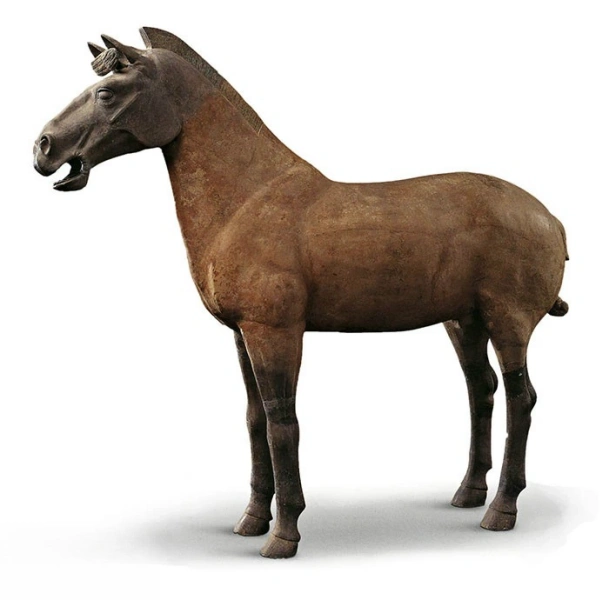
ม้าสำหรับอาน
ม้าอานถูกขุดพบในหลุมหมายเลข 2 สูง 1.72 เมตร สูงถึงไหล่ 1.33 เมตร ลักษณะโดยรวมไม่ใหญ่ ศีรษะหนา จมูกนูน คอสั้น แผ่นหลังโค้งเล็กน้อย อกกว้าง และแข็งแรง เหมาะสำหรับทั้งลากรถและขี่ ตามบันทึก Yunmeng Qin Jian ม้าอานส่วนใหญ่เลี้ยงในคอกม้าของทางการและอยู่ภายใต้การดูแลของข้าราชการตำแหน่ง “ซือหม่า” คุณภาพของม้าทหารจึงขึ้นอยู่กับการฝึกฝนและการจัดการโดยตรง ราชวงศ์ฉินขึ้นชื่อด้านการเลี้ยงม้า และมีทั้งคอกม้าหลวงและท้องถิ่นสำหรับกองทัพม้า
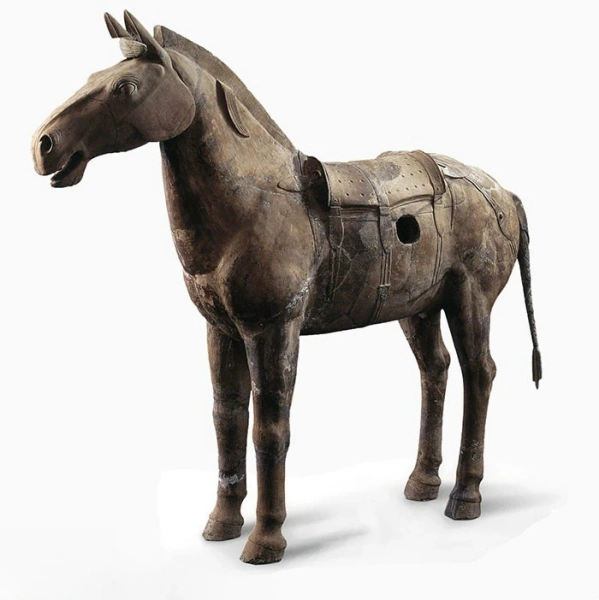
คำถามที่พบบ่อย
ได้ ศูนย์บริการนักท่องเที่ยวบริเวณทางเข้าด้านตะวันตกของลานเหนือมีบริการให้เช่ารถเข็นเด็กและรถเข็นผู้พิการ เพื่ออำนวยความสะดวกแก่นักท่องเที่ยวที่พาเด็กเล็กหรือผู้สูงอายุ
ได้ นักท่องเที่ยวสามารถถ่ายภาพได้ แต่ห้ามใช้แฟลชเพื่อปกป้องโบราณวัตถุ
มี อุทยานทหารดินเผามีบริการช่วยเหลือผู้สูงอายุและผู้พิการ นักท่องเที่ยวสามารถสอบถามรายละเอียดเกี่ยวกับรถเข็น ทางลาด และสิ่งอำนวยความสะดวกอื่นๆ ได้ที่ศูนย์บริการนักท่องเที่ยว
รวมลิงก์แนะนำเที่ยวซีอานที่จำเป็น
- คู่มือเที่ยวซีอานฉบับสมบูรณ์ 📖
- แนะนำที่พักในซีอาน 🏨
- คู่มือการเดินทาง ✈️ 🚇 🚄 🚆
- เคล็ดลับและข้อมูลจำเป็นในการเที่ยวซีอาน 🗺️ 🍜 📱 💸 🌤️ 💊

 English (US)
English (US)  繁體中文
繁體中文 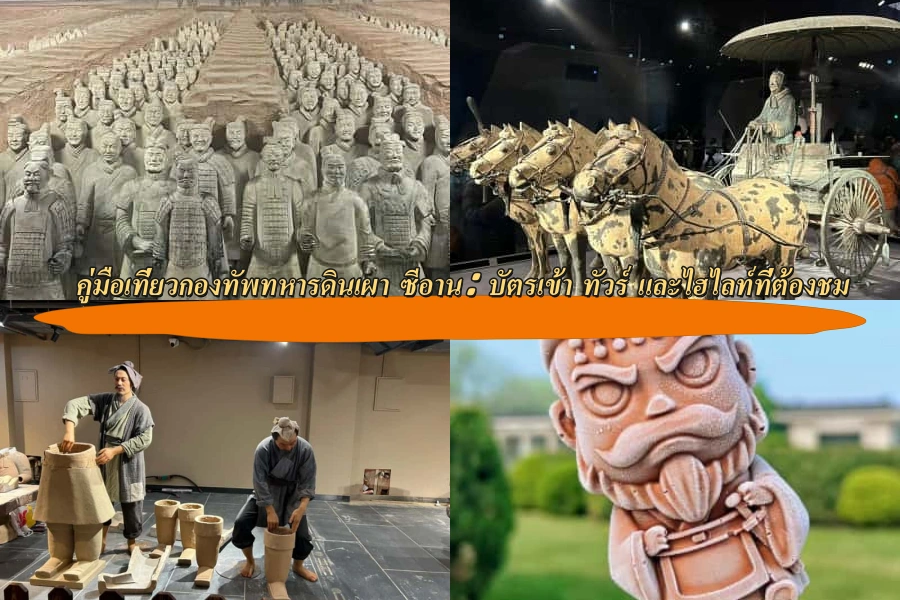
Comment (0)